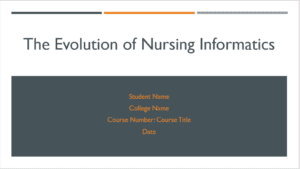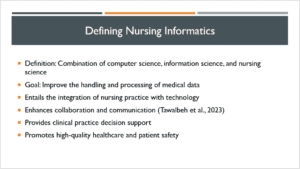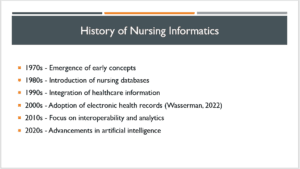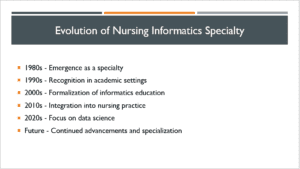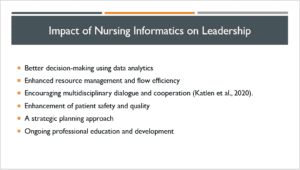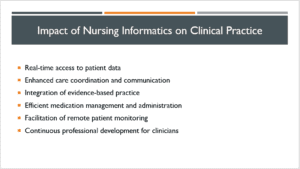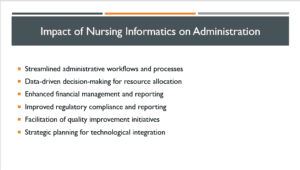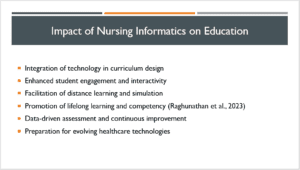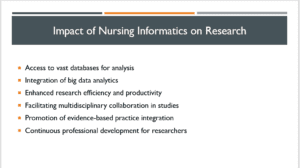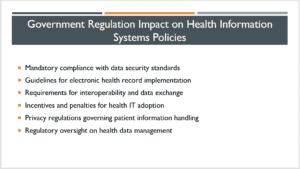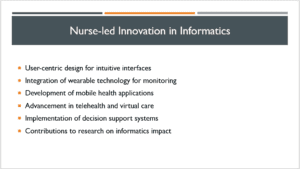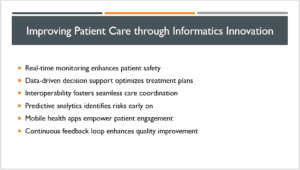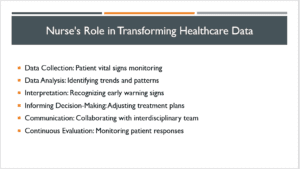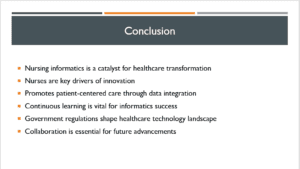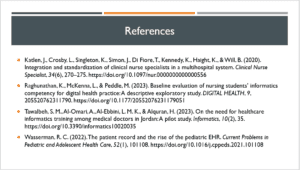The Evolution of Nursing Informatics
Hello and welcome to our presentation on “The Evolution of Nursing Informatics.” As advanced registered nurse leaders, we hold a unique opportunity to drive change through the practice of nursing health informatics. Today, we’ll delve into nursing informatics, explore its historical evolution, and discuss its profound impact on various aspects of healthcare. From leadership and clinical practice to administration, education, and research, we’ll uncover the pivotal role of nursing informatics. Additionally, we’ll examine how government regulations influence organizational policies and the crucial part nurse-led innovation plays in advancing informatics. Let’s embark on a journey through the dynamic landscape of nursing informatics.
The combination of computer science, information science, and nursing science is known as nursing informatics, and its goal is to improve the handling and processing of medical data. In order to maximize data utilization for patient care, it entails the seamless integration of nursing practice with technology. Enhanced patient outcomes are the result of enhanced communication and collaboration among healthcare providers, which is largely made possible in part by nursing informatics (Tawalbeh et al., 2023). In clinical practice, it offers decision support tools that help clinicians make well-informed decisions. By ensuring that healthcare providers have access to correct and timely information, nursing informatics helps to promote patient safety and high-quality healthcare. In sum, nursing informatics is a dynamic profession that is always changing and has an impact on how patient-centered care is delivered by making efficient use of information systems and technology.
The field of nursing informatics has a long history, rooted in early ideas that saw the possibility of combining information science with nursing science in the 1970s. The introduction of nursing databases in the 1980s represented a major advancement in the management and organization of healthcare data. Healthcare data began to be integrated in the 1990s, which set the stage for increasingly extensive and networked systems. Electronic health records became widely used in the 2000s, revolutionizing how patient data is recorded and accessible (Wasserman, 2022). The 2010s saw a shift in emphasis toward analytics and interoperability, with a focus on the necessity of smooth data flow and consumption. As the 2020s go on, advances in artificial intelligence will continue to shape nursing informatics, offering creative approaches to data-driven decision-making and better patient care.
The field of nursing informatics began to take shape in the 1980s due to the increasing convergence of nursing and technology. Formal education programs were developed as a result of the growing acknowledgment of nursing informatics in academic settings during the 1990s. The formalization of informatics education for nurses in the 2000s represented a major turning point by offering a disciplined path for specialization. The 2010s saw a noticeable increase in the application of informatics in nursing practice, with an emphasis on the role informaticists play in enhancing patient outcomes. The emphasis has changed to data science in the 2020s, and informaticists are crucial in utilizing data for evidence-based practice. With regard to the future, the specialty is well-positioned for additional specialization and breakthroughs, helping to promote the continuing transformation of healthcare through information systems and technology.
Nursing informatics greatly impacts nursing leadership. To begin with, it improves decision-making through data analytics and gives leaders real-time information to direct strategic efforts. Leaders may optimize the workforce and distribute resources effectively by implementing technology to improve process efficiency and resource management. By facilitating interdisciplinary communication and cooperation, nursing informatics integration promotes a cohesive healthcare team (Katlen et al., 2020). Furthermore, it ensures timely and accurate information is available for decision-making, which is critical in increasing quality and patient safety. Currently, nurse leaders are actively participating in informatics projects and strategic planning for technology integration. Finally, in order to ensure that leaders are capable of navigating the always-changing field of healthcare technology, nursing informatics requires leaders to engage in ongoing professional growth and learning.
Nursing informatics has transformed clinical practice in several ways. It gives doctors instant access to patient data and gives them up-to-date, thorough knowledge at the point of care. Also, care coordination and communication among healthcare team members have increased with the incorporation of informatics tools, resulting in more efficient and patient-centered care. In addition, the integration of evidence-based practice into routine clinical processes is greatly aided by nursing informatics, which guarantees that decisions are based on the most recent research and recommended practices. Further, electronic solutions make it easier to organize and administer medications efficiently, which lowers errors and improves patient safety. By extending care outside of traditional locations, the use of informatics tools also makes remote patient monitoring possible. It is imperative that clinicians engage in ongoing professional development to guarantee their proficiency in using the rapidly changing field of informatics technology.
Since nursing informatics reduces manual labor, streamlines administrative procedures and processes, and boosts overall efficiency, it significantly impacts healthcare administration. Administrators can optimize workforce numbers through data-driven decision-making for resource allocation made possible by the use of informatics. Additionally, informatics solutions enable improved financial administration and reporting by giving administrators rapid access to precise financial data that helps them make wise decisions. In addition, nursing informatics is essential to enhancing regulatory compliance and reporting and guaranteeing that healthcare companies follow industry standards. It makes quality improvement programs easier by giving administrators the information they need to pinpoint areas that need improvement. Moreover, in order to guarantee a smooth and effective healthcare administration system, administrators actively participate in strategic planning for technological integration, coordinating informatics activities with organizational objectives.
By incorporating technology into curriculum design, nursing informatics improves education and guarantees that students have the digital skills necessary for their future careers. By enhancing student interaction and engagement, informatics creates a dynamic learning environment that mirrors the state of technology in contemporary healthcare. It also makes distance learning and simulation easier, giving students access to online learning materials and a virtual environment in which to practice clinical scenarios. Nursing informatics prepares students for the ongoing improvements in healthcare by exposing them to emerging technology and encouraging lifelong learning and competency (Raghunathan et al., 2023). Informatics tools support data-driven assessment and continuous development, allowing teachers to measure student performance and improve their methods. Ultimately, nursing education embraces informatics to ensure that future nurses are well-prepared to navigate and contribute to the ever-changing landscape of healthcare technologies.
Research is revolutionized by nursing informatics, which gives researchers access to enormous databases for analysis and makes it easier to explore big datasets and extract valuable insights. Researchers may now examine healthcare data more thoroughly and identify patterns and trends thanks to the incorporation of big data analytics. Informatics streamlines the procedures of data collecting and analysis, increasing research productivity and efficiency. Additionally, it encourages interdisciplinary cooperation in research by uniting experts from different domains to offer a range of viewpoints. To guarantee that studies are based on the best available evidence, nursing informatics encourages the integration of evidence-based practice into research methodology. Additionally, researchers are urged to participate in ongoing professional development and stay current with new developments in informatics technologies and approaches in order to improve the caliber and significance of nursing research.
Government rules greatly impact how organizations formulate policies related to health information systems. Requiring healthcare firms to comply with data security standards lowers the risk of breaches and unauthorized access by ensuring that strong safeguards are put in place to protect patient information. Government rules frequently set guidelines for the implementation of electronic health records, influencing how businesses organize, handle, and use digital health records. Health information systems must interact easily to meet interoperability and data exchange requirements, which promote collaborative care amongst different healthcare organizations. Governments can influence organizational decisions about technology implementation by offering incentives or enforcing fines to encourage health IT adoption. Privacy laws, like the Health Insurance Portability and Accountability Act (HIPAA), control how companies handle patient data and how they distribute and manage it. Regulatory supervision of health data management guarantees that institutions follow set guidelines, encouraging openness, responsibility, and the provision of high-quality medical care.
Technology in healthcare is advancing significantly thanks to nurse-led innovation in informatics. Nurses are encouraging user-friendly experiences for healthcare professionals and patients by ensuring that informatics systems have intuitive interfaces through the use of user-centric design. The use of wearable technology in patient monitoring is spearheaded by nurses, who are improving real-time data collecting and analysis for more proactive and individualized care. Patients can now actively manage their own health owing to the expansion of healthcare services provided by the development of mobile health applications, frequently spearheaded by nurses. The advancement of telehealth and virtual care, which increases patient accessibility and convenience, is greatly aided by nurse-led innovation. Nurses also help put decision support systems into place, which improves clinical decision-making by incorporating evidence-based practices. Their participation in studies on informatics guarantees that new developments are based on real-world knowledge, which promotes an ongoing cycle of advancement and modification in medical technology.
Innovation in informatics is essential to improving the standard of patient care. Advanced informatics systems provide real-time monitoring, which improves patient safety by giving quick insights into vital indicators and warnings for important changes. Treatment plans are optimized by integrating data-driven decision support systems, guaranteeing that medical professionals access the most recent evidence-based procedures. Healthcare systems’ interoperability facilitates smooth care coordination and encourages productive dialogue and cooperation among healthcare providers. A result of informatics is predictive analytics, which helps to identify possible hazards early on and enable proactive interventions to avoid negative outcomes. With innovative informatics, mobile health apps allow patients to self-manage, stick to their drug regimen, and receive remote monitoring. Informatics systems’ built-in continuous feedback loop supports ongoing efforts for quality improvement by ensuring that patient care procedures change in response to actual facts and experiences.
In nursing informatics, nurses are essential in converting medical data into information that can be used to enhance patient care. For instance, a nurse in a medical setting uses informatics tools to get vital signs, such as heart rate, blood pressure, and oxygen saturation, in real-time. The nurse detects trends and patterns through data analysis, identifying departures from typical ranges. Subsequently, this data interpretation allows the nurse to identify early warning indicators of possible consequences. With this information, the nurse works with the interdisciplinary team to quickly modify treatment plans to guarantee a swift and suitable response. Beyond gathering and analyzing data, a nurse’s job also includes ongoing assessment, tracking patients’ reactions to interventions, and adjusting care plans in light of changing data. In the end, nursing informatics gives nurses the ability to turn unprocessed data into knowledge, enabling them to make more informed decisions and raising the standard of patient care overall.
One of the main drivers of the continuous transformation of healthcare is nursing informatics. Using the power of informatics to improve patient-centered care through smooth data integration requires nurses, who are major innovators. Healthcare personnel must study continuously due to the dynamic nature of informatics to use developing technology successfully. The policies and procedures that are implemented in the healthcare technology sector are greatly influenced by government laws. To propel informatics forward and guarantee that healthcare systems keep changing and adapting—and eventually enhance patient outcomes—collaboration across stakeholders in the healthcare industry is imperative. Healthcare will change significantly due to our dedication to innovation, education, and teamwork as we negotiate the always-changing field of nursing informatics.
Katlen, J., Crosby, L., Singleton, K., Simon, J., Di Fiore, T., Kennedy, K., Haight, K., & Will, B. (2020). Integration and standardization of clinical nurse specialists in a multihospital system. Clinical Nurse Specialist, 34(6), 270–275. https://doi.org/10.1097/nur.0000000000000556
Raghunathan, K., McKenna, L., & Peddle, M. (2023). Baseline evaluation of nursing students’ informatics competency for digital health practice: A descriptive exploratory study. DIGITAL HEALTH, 9, 205520762311790. https://doi.org/10.1177/20552076231179051
Tawalbeh, S. M., Al-Omari, A., Al-Ebbini, L. M. K., & Alquran, H. (2023). On the need for healthcare informatics training among medical doctors in Jordan: A pilot study. Informatics, 10(2), 35. https://doi.org/10.3390/informatics10020035
Wasserman, R. C. (2022). The patient record and the rise of the pediatric EHR. Current Problems in Pediatric and Adolescent Health Care, 52(1), 101108. https://doi.org/10.1016/j.cppeds.2021.101108
ORDER A PLAGIARISM-FREE PAPER HERE
We’ll write everything from scratch
Question
Assessment Description
As an advanced registered nurse leader, you have an opportunity to effect change through the practice of nursing health informatics. Informatics has evolved over time to become what it is today. Using the resources provided in this assignment, prepare a 12-15-slide PowerPoint presentation. Create speaker notes of 100-250 words for each slide. Include an additional slide for the title and references. For the presentation of your PowerPoint, use Zoom to create a video presentation. Refer to the topic Resources for additional guidance on recording your presentation with Zoom. Include an additional slide for the Zoom link at the beginning and another at the end for References.
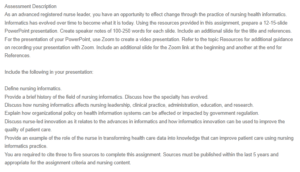
The Evolution of Nursing Informatics
Include the following in your presentation:
Define nursing informatics.
Provide a brief history of the field of nursing informatics. Discuss how the specialty has evolved.
Discuss how nursing informatics affects nursing leadership, clinical practice, administration, education, and research.
Explain how organizational policy on health information systems can be affected or impacted by government regulation.
Discuss nurse-led innovation as it relates to the advances in informatics and how informatics innovation can be used to improve the quality of patient care.
Provide an example of the role of the nurse in transforming health care data into knowledge that can improve patient care using nursing informatics practice.
You are required to cite three to five sources to complete this assignment. Sources must be published within the last 5 years and appropriate for the assignment criteria and nursing content.

